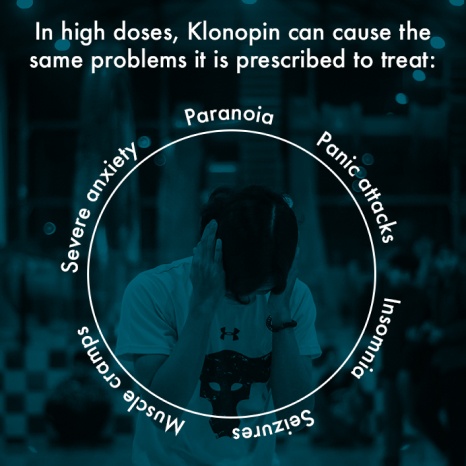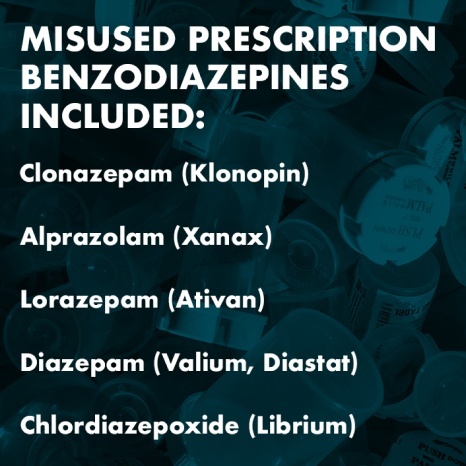Klonopin

In 2017, there were 29.2 million clonazepam prescriptions. Use is increasing which increases the risk for misuse and abuse.
KLONOPIN HIGH AND ABUSE
As with other benzodiazepines (commonly referred to as benzos), Klonopin abuse often starts when someone takes more than their prescribed dose to relieve anxiety or stave off a panic attack. This self-treatment creates a dangerous downhill slope that leads to frequent abuse, dependence, risk of overdose, and long-term side effects. Serious overdose and withdrawal problems can occur after the drug is abused even once, but with regular use, the risk is much higher.
In the medical world, Klonopin is almost never recommended for long-term use. Though it can be extremely powerful and effective in the short-term, patients can build tolerance to it quickly and become addicted even if they are not taking “too much.” Regular use can increase someone’s tolerance of Klonopin, reducing its effectiveness as relief from anxiety, seizure, or panic attacks. Instead, taking it begins to feel necessary for the sake of the high it creates.
MountainView Recovery
5475 Mark Dabling Blvd #102
Colorado Springs, Co 80918
Contact Us Today!
MountainView Resources!
KLONOPIN SIDE EFFECTS
Klonopin can manifest negative side effects even if abuse is not going on. The risk of these intensifies if someone is taking too much or continuing use for too long. Side effects include:
- Slowed motor skills
- Drowsiness and severe fatigue
- Irrational thoughts
- Paranoia
- Confusion
- Nightmares
- Mood swings and unexplained fits of anger
- Blurred vision
- Shallow breathing
- Bruising easily
- Muscle cramps
- Low blood pressure
- Loss of pleasure
SIGNS OF ABUSE AND OVERDOSE
Overdose can be deadly. In high doses, Klonopin can cause the same problems it is prescribed to treat:
- Seizures
- Muscle cramps
- Severe anxiety
- Paranoia
- Panic attacks
- Insomnia
Psychosis, hallucinations, heart palpitations, and cardiac arrest can also result from overdose. If someone has taken too much Klonopin or seems to be showing signs of an overdose, they should receive immediate medical attention.

WITHDRAWAL AND TREATMENT
After regular or long-term abuse, the severity of its withdrawal symptoms are a major reason that people return to it or find that they can’t stop. Furthermore, not only is withdrawal painful and mentally taxing, it can easily be life-threatening. Medical detox is almost always necessary when quitting Klonopin after abuse; people need to be weaned off the drug while under medical supervision. After someone safely moves through this medical detox phase, they can begin treatment to manage long-term withdrawal symptoms, which include:
- Depression
- Anxiety
- Intense cravings for the drug that can recur for months or years

FAQS:
“How many Americans abuse Klonopin?”
The National Survey on Drug Use and Health estimates that 5.4 million people, or 2 percent of the U.S. population, misused prescription benzodiazepines in 2018. These include clonazepam (Klonopin), alprazolam (Xanax), lorazepam (Ativan), diazepam (Valium, Diastat), and chlordiazepoxide (Librium) among others.
“How long do the effects of Klonopin Last?”
The euphoria, sedation, and other perceptible effects can last for many hours on end, and Klonopin stays in the body for up to several days. With regular or long-term use (especially in high doses), it can remain in the system and show up on drug tests for even longer.
“Is it dangerous to mix Klonopin with other drugs and alcohol?”
According to the National Institute on Drug Abuse, over 30 percent of opioid overdoses include benzos like Klonopin. Mixing Klonopin with any other depressant, including alcohol or other benzos such as Xanax, can exponentially increase the range of possible side effects. Mixing alcohol with prescription benzos can commonly cause nausea, vomiting, loss of consciousness, coma, and death. However, there is no way to accurately predict or prepare for the result of cocktailing Klonopin with other drugs.
TREATMENT
Mountain View Recovery Treatment Programs
Patient Resources
Addiction is complex, which means treatment and long-term recovery are complex. Despite this, it shouldn’t scare anyone – patients or their loved ones. It just means that treatment and recovery both require thorough and thoughtful planning.
Outpatient Program
Our outpatient program (OP) is a transition preparatory phase. It provides a minimum of nine (9) hours of weekly outpatient treatment. This involves a minimum of one (1) hour/s individual substance abuse/behavioral health counseling per week.
Adventure Therapy
For a long time, nature has been seen as a balm to the problems we face in society. Even during pre-industrial times, people would seek out the countryside as a means to feel better. Many people have also used nature as a way to understand the world.
Trauma and Recovery
Just like physical trauma occurs, so does psychological trauma. Any number of traumatizing events occur and cause psychological trauma. A lot of people will experience trauma before or because of addiction. It’s possible for addiction to deepen…
Neurofeedback
Nobody sets out with the intention of becoming addicted to anything. Even someone making a conscious decision to try substances is not intending to become dependent, experience withdrawal, and risk overdose or death. There are numerous factors.
